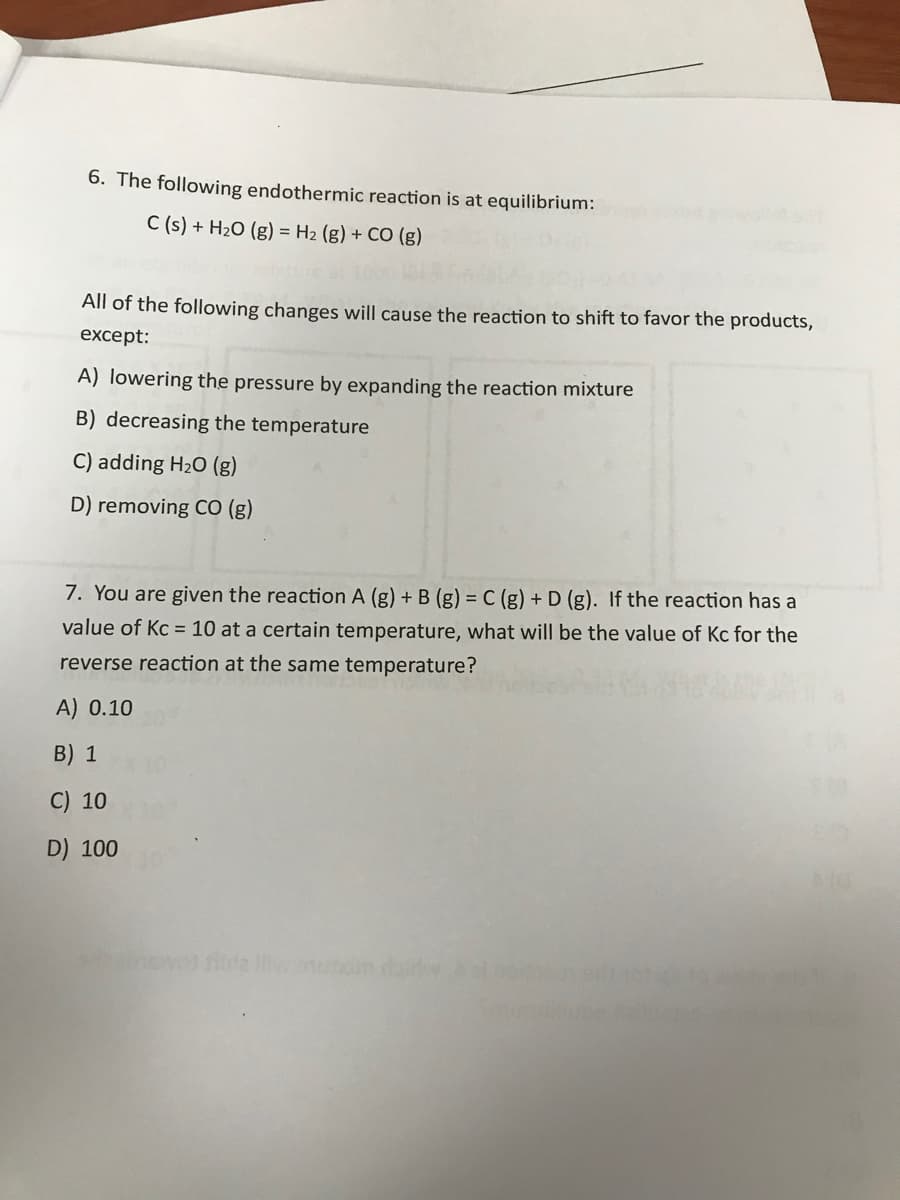6. The following endothermic reaction is at equilibrium: C (s) + H2O (g) = H2 (g) + CO (g) %3D All of the following changes will cause the reaction to shift to favor the products, except: A) lowering the pressure by expanding the reaction mixture B) decreasing the temperature C) adding H20 (g) D) removing CO (g) 7. You are given the reaction A (g) + B (g) = C (g) + D (g). If the reaction has a value of Kc = 10 at a certain temperature, what will be the value of Kc for the reverse reaction at the same temperature? A) 0.10 B) 1 C) 10 D) 100
6. The following endothermic reaction is at equilibrium: C (s) + H2O (g) = H2 (g) + CO (g) %3D All of the following changes will cause the reaction to shift to favor the products, except: A) lowering the pressure by expanding the reaction mixture B) decreasing the temperature C) adding H20 (g) D) removing CO (g) 7. You are given the reaction A (g) + B (g) = C (g) + D (g). If the reaction has a value of Kc = 10 at a certain temperature, what will be the value of Kc for the reverse reaction at the same temperature? A) 0.10 B) 1 C) 10 D) 100
Chemistry: An Atoms First Approach
2nd Edition
ISBN:9781305079243
Author:Steven S. Zumdahl, Susan A. Zumdahl
Publisher:Steven S. Zumdahl, Susan A. Zumdahl
Chapter12: Chemical Equilibrium
Section: Chapter Questions
Problem 3RQ
Related questions
Question

Transcribed Image Text:6. The following endothermic reaction is at equilibrium:
C (s) + H2O (g) = H2 (g) + CO (g)
All of the following changes will cause the reaction to shift to favor the products,
except:
A) lowering the pressure by expanding the reaction mixture
B) decreasing the temperature
C) adding H20 (g)
D) removing CO (g)
7. You are given the reaction A (g) + B (g) = C (g) + D (g). If the reaction has a
value of Kc = 10 at a certain temperature, what will be the value of Kc for the
reverse reaction at the same temperature?
A) 0.10
B) 1
C) 10
D) 100
fida iv m d
Expert Solution
This question has been solved!
Explore an expertly crafted, step-by-step solution for a thorough understanding of key concepts.
Step by step
Solved in 3 steps with 3 images

Knowledge Booster
Learn more about
Need a deep-dive on the concept behind this application? Look no further. Learn more about this topic, chemistry and related others by exploring similar questions and additional content below.Recommended textbooks for you

Chemistry: An Atoms First Approach
Chemistry
ISBN:
9781305079243
Author:
Steven S. Zumdahl, Susan A. Zumdahl
Publisher:
Cengage Learning


Chemistry
Chemistry
ISBN:
9781305957404
Author:
Steven S. Zumdahl, Susan A. Zumdahl, Donald J. DeCoste
Publisher:
Cengage Learning

Chemistry: An Atoms First Approach
Chemistry
ISBN:
9781305079243
Author:
Steven S. Zumdahl, Susan A. Zumdahl
Publisher:
Cengage Learning


Chemistry
Chemistry
ISBN:
9781305957404
Author:
Steven S. Zumdahl, Susan A. Zumdahl, Donald J. DeCoste
Publisher:
Cengage Learning

Chemistry for Engineering Students
Chemistry
ISBN:
9781337398909
Author:
Lawrence S. Brown, Tom Holme
Publisher:
Cengage Learning

Chemistry & Chemical Reactivity
Chemistry
ISBN:
9781337399074
Author:
John C. Kotz, Paul M. Treichel, John Townsend, David Treichel
Publisher:
Cengage Learning

Chemistry & Chemical Reactivity
Chemistry
ISBN:
9781133949640
Author:
John C. Kotz, Paul M. Treichel, John Townsend, David Treichel
Publisher:
Cengage Learning